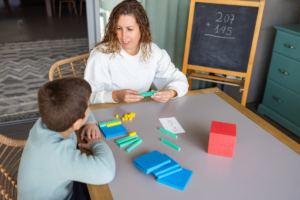
Tips for Adapting the School Curriculum for Students with Different Needs: Expert Advice
Adapting the school curriculum to meet the diverse needs of students is a challenge that educators face every day. With the increasing number of students with different learning needs, it is essential to develop strategies that can help teachers create an inclusive learning environment. Adapting the school curriculum is one such strategy that can help teachers meet the needs of all students.
Adapting the curriculum involves modifying the content, teaching methods, and assessment strategies to meet the needs of diverse learners. This can be achieved by incorporating different teaching strategies such as visual aids, hands-on activities, and group work. Teachers can also provide different levels of support to students based on their individual needs, such as providing extra time for assignments or providing additional resources for students who need them. By adapting the curriculum, teachers can create an environment where every student can learn and succeed.
In this article, we will discuss some tips for adapting the school curriculum for students with different needs. These tips will help teachers create an inclusive learning environment that meets the needs of all students. By following these tips, teachers can help students achieve their full potential and succeed academically.
Understanding Diverse Learning Needs
In order to effectively adapt the school curriculum for students with different needs, it is important to first understand the diverse learning needs that exist within the student population. Students with diverse learning needs may include those with disabilities, learning disorders, cultural or linguistic differences, and varying levels of academic ability.
One key aspect of understanding diverse learning needs is recognizing that every student is unique and may require different accommodations or modifications to the curriculum in order to succeed. For example, a student with a visual impairment may require materials in braille or large print, while a student with a hearing impairment may require an interpreter or captioning services.
Another important aspect of understanding diverse learning needs is recognizing that students may have different learning styles or preferences. Some students may learn best through visual aids, while others may prefer hands-on activities or verbal instruction. It is important for educators to provide a variety of instructional methods and materials to accommodate these different learning styles.
Additionally, cultural and linguistic differences can impact a student’s learning experience. Students who are English language learners may require additional support to understand and communicate in the classroom. Educators should strive to create a culturally responsive classroom environment that respects and values the diversity of their students.
Overall, understanding diverse learning needs is crucial for educators to effectively adapt the school curriculum and provide equitable learning opportunities for all students. By recognizing and addressing the unique needs of each student, educators can help create an inclusive and supportive learning environment.
Curriculum Differentiation Strategies
Curriculum differentiation strategies are essential for ensuring that students with different needs are able to access the curriculum effectively. These strategies involve modifying the content, adapting the process, and varying the product to meet the unique needs of each student.
Content Modification
Content modification involves changing the material being taught to better suit the needs of the student. This can include simplifying the language used, using visuals to support understanding, and providing additional resources to help explain difficult concepts. Teachers can also modify the content by providing alternative texts or materials that are better suited to the student’s learning style or interests.
Process Adaptation
Process adaptation involves changing the way in which the material is taught to better suit the needs of the student. This can include providing additional support during instruction, such as one-on-one instruction or small group work. Teachers can also adapt the process by providing additional time for students to complete assignments or assessments, allowing for breaks during instruction, or providing additional scaffolding to support understanding.
Product Variation
Product variation involves changing the way in which students demonstrate their understanding of the material. This can include providing alternative assessment methods, such as oral presentations or visual projects, or allowing for students to demonstrate their understanding in a variety of ways. Teachers can also vary the product by providing additional resources or support to help students complete assignments or assessments.
By utilizing curriculum differentiation strategies, teachers can ensure that all students are able to access the curriculum effectively and achieve academic success.
Inclusive Teaching Techniques
Collaborative Learning
Collaborative learning is an effective technique for adapting the school curriculum for students with different needs. It involves students working together in small groups to achieve a common goal. This technique helps to promote social interaction, communication, and teamwork among students. Teachers can use this technique to create a positive learning environment where students can learn from one another.
Multisensory Approaches
Multisensory approaches involve using multiple senses to teach a concept. This technique is particularly useful for students with different needs as it allows them to learn in a way that suits their learning style. For example, teachers can use visual aids such as pictures, videos, and diagrams to help students who are visual learners. Similarly, teachers can use hands-on activities such as experiments and projects to help students who are tactile learners.
Assistive Technologies
Assistive technologies are tools and devices that help students with different needs to access the school curriculum. These technologies can include text-to-speech software, screen readers, and speech recognition software. Teachers can use these technologies to help students who have difficulty reading, writing, or communicating. By providing students with the necessary assistive technologies, teachers can ensure that all students have equal access to the school curriculum.
Assessment and Evaluation
Assessment and evaluation are crucial components of adapting the school curriculum for students with different needs. It helps teachers to identify the strengths and weaknesses of their students and adjust their teaching methods accordingly.
Formative Assessments
Formative assessments are an ongoing process that helps teachers to monitor their students’ progress and adjust their teaching methods accordingly. It includes quizzes, class discussions, and homework assignments. These assessments help teachers to identify the areas where their students are struggling and provide them with additional support.
Summative Assessments
Summative assessments are used to evaluate the learning outcomes at the end of a unit or course. It includes tests, exams, and projects. These assessments help teachers to determine whether their students have achieved the desired learning outcomes and adjust their teaching methods accordingly.
Individualized Education Plan (IEP) Goals
Individualized Education Plan (IEP) goals are specific learning objectives that are developed for students with disabilities. These goals are developed based on the student’s individual needs and abilities. Teachers use these goals to develop a curriculum that is tailored to the student’s needs and abilities.
In conclusion, assessment and evaluation play a critical role in adapting the school curriculum for students with different needs. Teachers should use formative and summative assessments to monitor their students’ progress and adjust their teaching methods accordingly. Additionally, teachers should develop individualized education plan goals for students with disabilities to ensure that their needs are met.
Professional Development for Educators
In order to effectively adapt the school curriculum for students with different needs, it is essential for educators to receive proper professional development. This will help them to better understand the needs of their students and how to cater to those needs in the classroom.
Professional development for educators can take many forms, including workshops, conferences, online courses, and peer-to-peer learning opportunities. These opportunities can provide educators with the knowledge and skills necessary to adapt the curriculum to meet the needs of all students, including those with disabilities, learning differences, and other challenges.
One important aspect of professional development for educators is the opportunity to learn about the latest research and best practices in the field of special education. This can help educators to stay up-to-date on the latest trends and to incorporate evidence-based practices into their teaching.
In addition to learning about specific strategies and techniques for adapting the curriculum, professional development for educators can also focus on building empathy and understanding for students with different needs. This can help educators to create a more inclusive classroom environment and to better meet the needs of all students.
Overall, professional development is a crucial component of adapting the school curriculum for students with different needs. By investing in ongoing training and development for educators, schools can ensure that all students receive the support they need to succeed.
Engaging Parents and Communities
Adapting the school curriculum for students with different needs requires the support and involvement of parents and communities. Engaging parents and communities can help educators understand the unique needs of their students and provide the necessary support to help them succeed.
One effective way to engage parents and communities is to create a welcoming and inclusive environment. Educators can achieve this by providing regular communication with families, such as newsletters, emails, or parent-teacher conferences. Additionally, educators can create opportunities for parents to get involved in the classroom, such as volunteering or attending school events.
It is also important to involve the community in the curriculum adaptation process. Educators can seek input from community members, such as local business owners or community leaders, to help them understand the needs of their students. Additionally, educators can partner with community organizations to provide additional support and resources for their students.
By engaging parents and communities, educators can create a collaborative and supportive environment that helps students with different needs succeed.













Publicar comentário